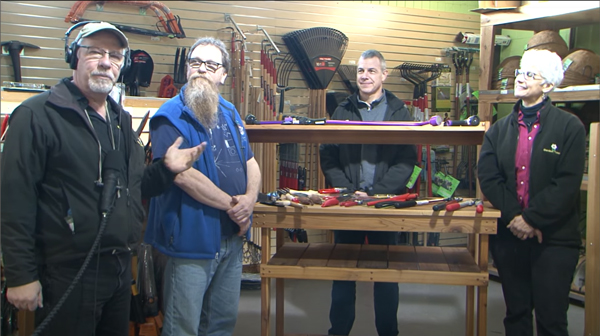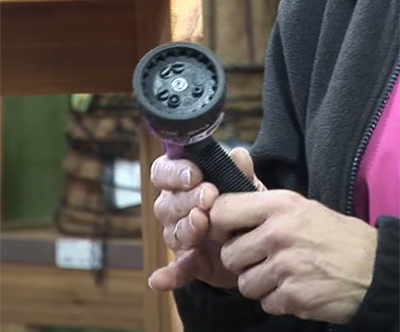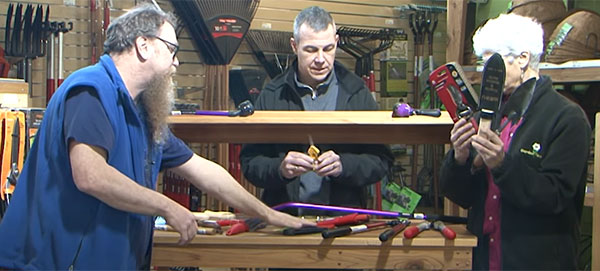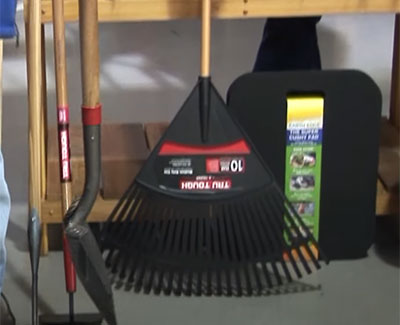|
Season 2 • Episode 3 - February 18, 2023

People are always asking what types of tools do I REALLY
need in the garden. Well, we have come up with the basic
CCD. That means Cutting, Cultivating and Digging tools.
We visited the tool wall at the local Portland Nursery
on Stark to talk with Jimmy. He is the hard goods buyer
for both locations and that means he buys all the tools
that you see at both stores. He had a nice collection of
basic tools for beginners and also some tools for the
advanced gardener. We started with the smaller hand
tools first. Jimmy talked about having a good quality
tool in your garden. This may mean that you will pay a
little more, but you will be rewarded in the long run.
Strong, forged handles and blades, instead of folded
metal, can guarantee that your tools will be able to
handle anything in your garden.
Some Basic Hand Tools for the Beginner or Small Garden
A hand trowel for digging. Once again a good solid,
heavy duty trowel for getting big (or small) scoops of
soil. This tool will dig, divide and cultivate soil.
It's like having a mini-shovel in your hand. Since this
is a tool for digging you will want it to feel good in
your hand. That is true for all your tools. They should
fit your hand well and not create additional strain or
pain. Jimmy used a trowel from
Red Pig Tools which was forged so it would handle
any job in your garden.
A hori hori knife. This, too, can be used for digging.
It is a Japanese weeding tool or some call it a 'soil
knife'. It has a relatively sharp side and a serrated
side to the blade. The sharp side is good for cutting
into tough soil and cutting open bags of soil and twine
and rope. The serrated side is good for cutting and
dividing roots during transplanting. It is also great
for planting bulbs and digging holes for smaller plants.
Pruners were next. You need a good solid pair for
cutting. We recommend the Felco pruners, because they
are well made, come in different sizes for different
hands, and have replaceable parts so you don't need to
replace the whole pruner. They also come in various
sizes so you can pick the one that fits best in your
hand. Jimmy also had a pair of Corona pruners which are
good and a little cheaper than the Felcos. If you are a
new gardener you will find a couple different types of
pruners, bypass and anvil. Bypass pruners are preferred
by most gardeners and are the most popular pruners on
the market. The main blade 'bypasses' a flat edge and
slices through the plant material making a clean cut. An
anvil pruner has a blade that hits the flat edge and
makes a 'crushing' cut to the plant material. Take a
look at both types when choosing your tool so you get
the one that you prefer.
For cutting larger branches you may look at pruning
saws. Felco also makes a nice tool that can cut through
branches up to six inches in diameter or larger.
Remember to have good footing, wear safety gear and, for
safety reasons, try not to cut above your head. Loppers
are just larger pruners and hedge trimmers have a large
cutting surface for hedges and ornamental grasses. The
longer handles give you the leverage to cut those large
branches, but if the branch is too big you can damage
the lopper and you should go with the pruning saw.
 One
of the small tools that is easily overlooked is watering
tools. These are your hoses, spray nozzles and shutoff
valves to help you water and control the water that you
use. We looked at some of the watering tools from
Dramm.
A good hose will not kink or burst over time and helps
you apply water to where you need it most without
wasting it. Good sprinklers and spray nozzles are
essential for controlled application. Dramm makes a
watering wand and nozzle that has multiple settings so
you can go from a stream of water to a soft rain by just
turning the dial. These are built so that you can drag
them around on the ground and they will hold up to the
beating. They are so tough, they are the watering tool
that most garden centers and nurseries use. One other
thing that you would need would be a shutoff valve that
you can control at the end of the wand. Then you can
turn on and shut off the water when you need it, without
going back to the spigot at your house. One
of the small tools that is easily overlooked is watering
tools. These are your hoses, spray nozzles and shutoff
valves to help you water and control the water that you
use. We looked at some of the watering tools from
Dramm.
A good hose will not kink or burst over time and helps
you apply water to where you need it most without
wasting it. Good sprinklers and spray nozzles are
essential for controlled application. Dramm makes a
watering wand and nozzle that has multiple settings so
you can go from a stream of water to a soft rain by just
turning the dial. These are built so that you can drag
them around on the ground and they will hold up to the
beating. They are so tough, they are the watering tool
that most garden centers and nurseries use. One other
thing that you would need would be a shutoff valve that
you can control at the end of the wand. Then you can
turn on and shut off the water when you need it, without
going back to the spigot at your house.
A handheld garden fork or three-tine cultivator is also
useful. These forks are used to break up soil and rake
up small areas of debris. We recommend getting a good
SOLID, heavy duty fork. This means the tines will stand
up to deep and repeated digging. Once again, look for
forged, solid metal and not folded metal handles and
tines.
We finished this part of the podcast with Jimmy
narrowing down the main tools you should consider if you
are new to gardening. He mentioned that a collection
including a good trowel, the hori hori knife, an
excellent hand pruner and a small hand saw should help
you get started.

We then took a break to hear from our great sponsors
including Capitol Subaru and Portland Nursery and then
returned to talk about long handled and larger tools for
your garden.
More Advanced Tools for Larger Gardens
For cultivating you may want a hoe for removing weeds
and creating rows for planting. There are a lot of hoes
on the market and you can even find a few that have a
double head on them. One side will have a hoe blade and
the other will have a multiple tine tool for cultivating
the soil. Once again look for good construction with
strong metal blades and durable handles so they don't
break in the garden. One cultivator that Jimmy had
looked like a bunch of cowboy spurs on a handle. These
multiple 'spurs' were wheels full of spikes that worked
together to rototill the soil, breaking it up and
pulling out the weeds at the same time.
Good gloves are essential. As gardeners, we go through a
lot of gloves and most of the Garden Time crew have
multiple pairs that we use in the garden. Jimmy likes a
good nytril glove that is breathable and Ryan also has a
heavy duty pair of leather gloves for larger jobs and
dealing with thorny bushes and plants. We also talked
about the
Garden Like a Girl Weedies. These are gloves
designed for women, but we know of a few men who use
them, too. They are durable and have Kevlar incorporated
in them to prevent the finger tips from wearing out. Of
course you should remember to wear long sleeves and a
hat when gardening to prevent cuts, scrapes and sunburn.
Also, wear sunscreen on exposed skin and drink water
frequently with breaks mixed in.
The next thing that Jimmy had on his list was a knee
pad. A nice cushy pad will save your knees and lead to
less fatigue in the garden.
And for digging there is nothing like a good spade or
shovel. There are many different types, so make sure the
one you get has a strong handle, the right blade for the
job and is comfortable in your hands. One that has
become one of Jimmy's favorites is called the 'Root
Slayer'. This is a nasty looking tool! It has a blade
like a regular shovel, but the edges of the blade have
teeth so it not only digs, it can cut through a lot of
thick roots too. It also has a round loop on the handle
to give you more leverage when you are digging and
prying out the root ball. Most people can do well with a
smaller 'floral shovel'. This has a smaller blade and it
can do well in those smaller gardens. A larger shovel
can dig more soil, but that also means more strain on
your arms and back. A smaller shovel will cause less
strain for most people. No matter what size of shovel,
look for one with a good strong handle and a nice wide
foot deck (the place at the top of the shovel where you
place your foot) to get the best leverage when digging.
A rake for breaking up the soil, leveling the soil and
cleaning up debris in your beds, and a large garden fork
(thicker than a pitchfork) for breaking up the soil and
digging are also good to have.
Finally, we talked about having a debris bag or
something to put your yard debris in to take it to your
recycling or compost bin. Having something to carry will
make your work more efficient and give you an excuse to
get up and move around so you get an occasional break
from work.
 The
top three long handled tools that Jimmy would recommend
for the beginning gardener include a shovel, a rake and
a hoe/cultivator. Always look for a good handle size so
you are not always hunched over and putting a strain on
your body. The
top three long handled tools that Jimmy would recommend
for the beginning gardener include a shovel, a rake and
a hoe/cultivator. Always look for a good handle size so
you are not always hunched over and putting a strain on
your body.
All these tools can be found at most of your independent
garden centers. If you have questions or are looking for
a specialized tool, make sure you stop by either
location of Portland Nursery and ask the helpful staff.
Remember, the right tool for the job makes that job
easier! Once you have all your essential tools, the
Portland Nursery website has a
great list of brochures to help you with all your garden
chores.
Now that you have these great tools, taking care of them
will help them last longer. As Jimmy mentioned, he has
some tools that have lasted over 20 years. That is
because he does basic maintenance on them every year.
Spring is a good time to give them a good cleaning and
sharpening. Clean and sharp tools will make your garden
chores much easier. Some tips to follow include using
alcohol or bleach and steel wool to scrub them clean and
disinfect them. Then you want to use a sharpening stone
or file to give a good sharp edge to them to make the
cutting easier. Remember to only sharpen the beveled
edges of the blades! Also, if you have a pruning saw,
take it to a professional or buy a new one. They are
just too dangerous to attempt on your own. Your local
garden center has all the tools you need and they can
even demonstrate how to use them correctly. Do a little
sharpening now and all your spring and summer garden
work will be a breeze!

PODCASTS
2022
• Return to Current Year Podcast List
 |